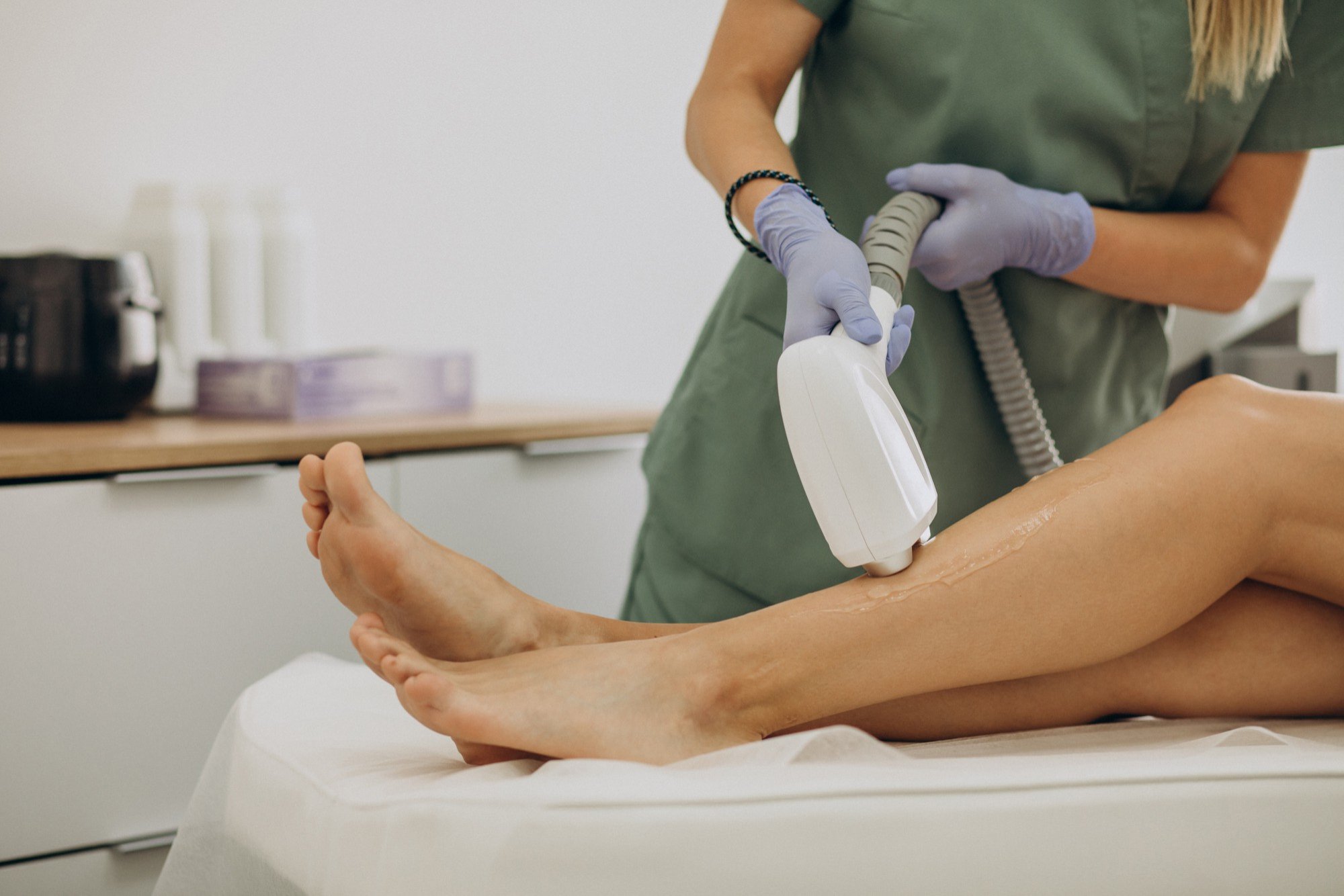
Laser Hair Removal
Managing excessive or unwanted body hair can be a real nuisance for both men and women. Common solutions include shaving, waxing, tweezing and depilatories, but they can be tedious, painful, costly and time-consuming. They are also temporary. We know that excessive hair growth can embarrassing and frustrating, leaving you feeling less than your best. We hate it too.
Recent advancements in laser technology have provided patients with an effective and long-lasting solution for reducing or eliminating the appearance of unwanted hair growth. With little to no discomfort or downtime, laser hair removal delivers lasting silky smooth skin by preventing hair from regrowing.
How Does It Work?
In a series of laser hair removal treatments, you can often achieve the soft, flawless skin you desire and say goodbye to temporary hair removal methods for good.
How Does Laser Hair Removal Work?
Lasers emit a targeted beams of light directly into the hair follicle. It is important to note that this light is attracted to the melanin present in your hair, which is what gives your hair and skin its pigment. When the laser light enters the hair follicle, it heats and damages the hair bulb to prevent future regrowth. The device settings are calibrated to the specifics of each patient based on the color and coarseness of their hair, to ensure both the maximum light absorption by the follicles, and that there is no damage to the skin surrounding the area. Laser hair removal is not a painful procedure, yet provides a safe and effective way to achieve lasting smoothness.
The Phases Of Hair Growth
Hair strands grow from hair follicles in your skin. At the base of each follicle is a living bulb, which contains active cells that divide and grow to create hair. Blood vessels nourish the bulb, delivering hormones which affect hair growth. From the beginning of hair growth, to the hair falling out, the strands go through four stages.
Anagen Phase
This is the active phase of hair growth. During the anagen phase, your hair grows as the cells in the bulb at the root of the hair divide rapidly. Each strand is in the anagen phase for two to seven years, making this is the longest-lasting period of the growth cycle. At any time, about 90% of your hairs are in the anagen phase.
Catagen Phase
In this transitional phase, hair growth slows as follicles shrink. Hair strands disconnect from their blood supply and the cells that produce new hair, becoming dormant. The catagen phase lasts approximately 10 days. Only about 5% of your hairs are in this phase at any given time.
Telogen Phase
The telogen phase is a resting period. During this stage of the cycle, the hair follicle is entirely inactive and no longer growing. The follicle typically remains dormant for around three months before the cycle begins again. An estimated 10-15% of your hairs are in this phase at the same time.
Exogen Phase
Shedding occurs in the final step of the cycle. At the end of the resting period, also known as the exogen phase, the hair gradually detaches from the follicle and falls out. The average person loses 50-100 hair strands each day.
Each hair follicle operates independently and progresses through the growth cycle at different times. If it didn’t work that way, all your hair would fall out at once! These growth cycles impacts laser hair removal in two ways:
First, laser hair removal treatments are most effective on hairs that are in the anagen phase. Because it is highly unlikely that every hair treated on a given day will be in the anagen phase, multiple treatments are needed to ensure every hair in the selected area is reached during the optimal stage of its growth cycle.
Secondly, hair growth cycles vary for different people and on different parts of the body. The optimal number of laser hair removal treatments for you may not be the same as the optimal number of treatments for someone else.
Why Laser Hair Removal?
Noninvasive treatment
Quick and convenient treatment sessions
Customizable treatment settings
Safe for many hair colors and skin types
Can treat most areas of the body and face
Little to no discomfort
No downtime
Low risk of side effects
Long-lasting results
Cost-effective in the long-term
Am I A Good Candidate For Laser Hair Removal?
In the past, only individuals with fair skin and dark hair saw fast and lasting results with laser hair removal due to the contrast between the amount of melanin present in their skin and hair. Generally speaking, the more melanin present in the skin or hair, the darker it will be. The prevalence of melanin in darker skin tones potentially put patients at greater risk, while the lack of melanin in blond, red, gray and white hair meant that lser treatment were less effective or not effective at all.
Today, laser hair removal can be a safe and highly effective treatment for patients with a variety of skin tones and hair colors, including those with dark skin and dark hair. During your initial consultation, Dr. Prieto will carefully assess your concerns and goals to determine if laser hair removal is right for you.
What Areas Can Be Treated?
Laser hair removal can be used to treat any area of the body where you have unwanted hair growth — even delicate areas such as the face or bikini region. Some of the most common treatment areas for men and women include:
Underarms
Arms
Legs
Chest
Stomach
Back
Bikini area
Face and neck
What Lasers Do You Use For Hair Removal?
Privvy Modern Health uses industry-leading lasers from Cutera® for hair reduction treatments. All hair reduction is done with the Cutera Xeo®
Cutera Xeo®
Nd:YAG laser technology
Customizable treatment options
Appropriate for all skin types
Cooled handpiece increases patient comfort
truPulse technology delivers constant, sustained energy for rapid results
ProWave LX technology delivers effective results for patients with light, fine hair
What Is The Best Time To Have Laser Hair Removal Treatments?
You can schedule these treatments at any time, but it's best if you do not have a tan. Typically we want to avoid the summer, but if you like going to Mexico in February, make sure to schedule hair removal well in advance of this. Once you're back, we need to wait until your tan subsides before continuing your treatments.
Preparing For Laser Hair Removal
Laser hair removal will require some preparations in the weeks leading up to your first appointment. Avoid temporary hair removal methods such as waxing, plucking or depilatories for at least six weeks prior to your laser hair removal session to ensure the laser can identify the melanin in the hair follicle. You will also need to shave your desired treatment area(s) 24 hours before your appointment. Tanning prior to treatment — including the use of self-tanners — is a no-no: This can increase the risk of pigment changes after the laser treatment.
During your initial consultation, our laser specialists will provide you with all pre-treatment instructions to maximize the safety and effectiveness of your procedure.
What To Expect From Your Laser Hair Removal Treatment
When you arrive for your laser hair procedure at Privvy Modern Health, your treatment areas will be cleaned and prepped, and a topical numbing cream may be applied if you have concerns about your comfort during treatment. Both you and your laser specialist will wear protective eyewear to filter out any harmful light throughout your treatment. Thsi is standard in all of our laser procedures.
During the procedure, your laser specialist will hold the skin of your treatment area taut and use a handheld applicator to deliver concentrated light pulses directly into your hair follicles. Patients often liken the sensations experienced during laser hair removal to the feeling of a rubber band being snapped against their skin. However, thanks to the contact-cooling feature on our laser device, these sensations are generally well-tolerated. The melanin in the hair will absorb the thermal light energy which, in turn, vaporizes the hair so that it cannot grow back.
The duration of your treatment will vary depending on the size and number of treatment areas. Smaller areas such as the chin or upper lip may only take a few minutes to treat, whereas larger areas like the legs can take up to an hour.
How Many Treatments Will I Need?
The number of treatment sessions you will require to achieve optimal results will be determined by several factors, including your skin type, hair density, hormones and natural hair growth cycle. We typically recommend our patients undergo six to twelve treatments spaced six to eight weeks apart for best results.
By undergoing a series of treatments, we can ensure that the majority of hairs in your target area is reached during the anagen phase when the treatment is most effective, and you remain stubble-free. With each successive treatment, you will see fewer and fewer hairs return. Finishing the recommended course of treatment in full assures that you achieve the highest degree of (it’s not permanent due to hormones/body) hair reduction possible.
Is There Any Downtime Needed After Laser Hair Removal?
No downtime is needed after your laser hair removal appointment. While you may experience some redness and swelling in the treated area or areas, most patients will usually resume normal activities or return to work right away. These side effects are generally mild and should resolve within a few days. Be sure to follow your laser specialist’s instructions for post-treatment care, including avoiding sun exposure and tanning, specific hair removal methods and any skincare products that could cause irritation.
What Results Can I Expect From Laser Hair Removal?
While laser hair removal treatments are quick and painless, it will take some time for the results of your treatment sessions to become apparent. Over the weeks following your hair removal appointment, your treated hair will gradually shed. Don’t be concerned if you see what looks like regrowth soon after treatment — this is actually the treated hair pushing itself out of the follicle and falling out. Shaving is permissible between appointments.
After completing your recommended course of treatment sessions, you can remain smooth and hair-free for months or even years. If hair regrowth occurs, the hair is often finer, lighter in color and less noticeable. Occasional touch-up treatments may be required to address new hair growth that appears over time.
Book a consultation with Dr. Prieto to get started, and she ca explain anything we've missed here. She'd be happy to discuss all your health concerns during your appointment, so please ring your questions.
